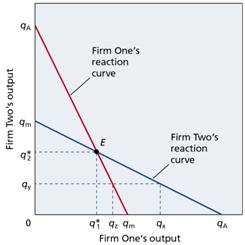Blah blah blah, yes I talk about Micro a lot.
But these two classes have been overlapping like crazy to me lately. They’re both using ambiguous models that tend to confuse the crap out of me.
In micro, we’re talking about oligopolies. Oligopolies focus on the most important firms in a market. It’s pretty much in between perfect competition (with a lot of firms fighting for consumer money) and monopoly (with one big guy making production decisions), but it’s categorized more towards the monopoly end of the spectrum.
Like FOM, Micro uses a lot of models for more of a self-reference tool to see how economics works in theory, only to apply it to real world situations later. The three models we’re talking about right now are the Cournot Model, the Bertrand Model, and the Stakelberg Model.
Kickin’ It With Cournot
With every economic (or other any field really) model, you’ve got to assume some things first. This model keeps it simple, and only keeps up with two firms in the market, which is called a duopoly. You’ve also got to assume that each extra unit of output produced costs the companies nothing (Marginal Cost = 0; but the model can compensate for positive, constant marginal coast if need be). The last assumption is stretching a little, but it’s crucial to make this model work. We need to imagine that each firm assumes that the other (it’s rival) will continue producing at it’s current level.
Basically this model shows how each firm will react to it’s rival’s output, through two reaction functions. Through brutal algebra, we can take a total demand function and marginal cost, and tell you how much each firm will produce, what price they’ll charge, and even how much money they’ll probably make out of it.
 This graph shows the stable equilibrium of a Cournot duopoly. At point E, there is no need to react any differently and revise output, because both firms are acting according to the other’s assumptions. This equilibrium is called the Nash equilibrium, named after a really cool (but crazy) math/econ dude. If you have not seen A Beautiful Mind, you need to.
This graph shows the stable equilibrium of a Cournot duopoly. At point E, there is no need to react any differently and revise output, because both firms are acting according to the other’s assumptions. This equilibrium is called the Nash equilibrium, named after a really cool (but crazy) math/econ dude. If you have not seen A Beautiful Mind, you need to.

Ballin’ Bertrand Model
The Bertrand Model is much simpler, and makes most of the same assumptions the Cournot model makes, but imagines that firms are reacting off of announced prices.
Say Firm 1 announces their price on a product. Firm 2 has three options. They can charge a higher price, and sell nothing. They can charge the same price, and split the market with Firm 1. OR, they can charge a lower price, and capture the whole market. Both firms obviously want to make the most amount of money, so both of them strive to undercut prices just low enough to make some money, but to be lower than their rivals price (think price matching at grocery stores).
This actually works against both of them. Both firms will end up cutting prices so low, that price will be set equal to the amount it took to make that one extra unit (MC), and the firms will split the market.
Silly firms.
Stackelberg Swag
The Stackelberg Model is probably the most realistic of all three models. It considers two models, but takes into consideration that one firm is more experienced than the other. We treat the follower’s output level as given, and substitute the follower’s reaction function into the market demand equation to find the leader’s output.
This makes sense intuitively, because the follower firm is really the only firm doing the reacting. The leader firm is the one making the big decisions.
The take away message from these three models is very simple: the more competition you have in a given market, the more output and lower prices you’ll get. Competition is a good thing, people.
Anyways, these models all seem simple enough, but when put to the real-life application test, they seem to break apart. You can’t just assume that companies will act rationally.
I’m just thinking about all of the high-school algebra I have to work through to make any three of these models work for my Micro final.



















